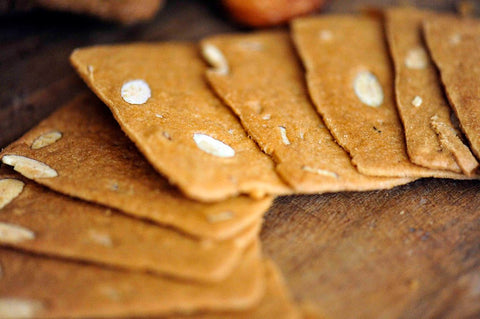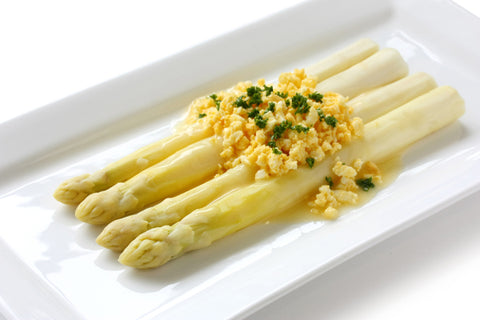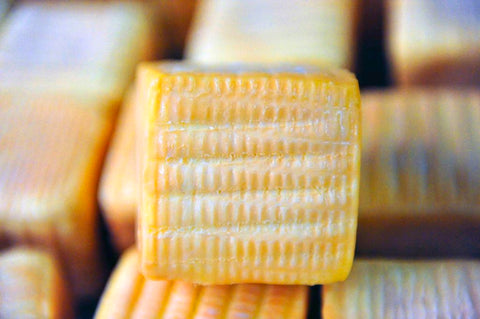- No products in the cart.
Chocolate

Chocolate is of such importance in Belgium that it deserves its own page. You could say this is proven by the fact that Belgians eat 8 kilo's of the stuff each and every year. Of course, chocolate has many creators but, with the possible exception of Switzerland, there's only one country on the face of the earth that has such a passionate and deep-rooted love affair with chocolate as Belgium does.
Some say that after beer, chocolate is the country’s international sweetheart. Innovation is part of that passion. It was in Brussels, in 1912, that Jean Neuhaus, son of a Swiss pharmacist, created Belgium's signature chocolate confection – the praline (a filled chocolate bonbon).
Naturally enough, the country has an 'assorted tray' of chocolate museums, the two prominent ones being found in Bruges (called "Choco-Story") and in Brussels (the Museum of Cocoa & Chocolate, or MUCC).
And, just as with everything food- and drink-related in the country of Belgium, its chocolatiers don't stop their innovating. New types of chocolate, new recipes and novel pairing tips are being developed here, year after year. Most interestingly there are even dare-devils moving, a nibble-and-sip at a time, to finding a place for beer, when it comes to taste-pairings with chocolate.
With such novel and flavour-filled explorations, it seems certain that chocolate will continue to be central to Belgium's gastronomic identity – past, present and future.
Origin & History

The raw material of chocolate, cocoa, thrives in a small zone close to the Equator known as the cocoa belt. Native to tropical Central and South America the cocoa tree or theobroma cocoa probably originated in the Amazon basin. it’s grown in Africa, Asia, the Caribbean, Central and South America.
Most of the world’s chocolate is now produced with cocoa grown in the plantations of Ghana and Ivory Coast in West Africa.
The scientific name, theobroma cocoa, derives from ancient Greek and translates literally as ‘cocoa food of the gods’.
Although it might not be truly divine, since man discovered it cocoa has been highly valued and supposedly blessed with many beneficial properties. Cocoa has been used – with varying degrees of scientific justification - as a medicine, an aphrodisiac and a mood-enhancer amongst many other things.
Chocolate is at least 3,000 years old. Early Central American civilizations were the first to grow cocoa as a crop and they integrated it into both their daily lives and their religion.
The Mayans ground the beans and made them into a frothy bitter chocolate-like drink which they seasoned with spices, chillies and vanilla.
The Aztecs took over the Mayan tradition, renaming the drink “xocolatl” and making it a central part of their culture. This is the root of our modern chocolate habit.
From Bean To Bar
As European explorers and settlers arrived in the New World cocoa found its way oversees. In Europe the Spanish quickly sweetened up their drinking chocolate by ditching the chilli and adding cane sugar, honey and cinnamon. By the 17th century, chocolate drinking had taken Europe’s courts by storm.
Through the centuries the drink was refined and improved, but it was still light years away from what we think of as chocolate today and remained an expensive delicacy available only to the wealthy and well-connected.
It wasn’t until the end of the 1700’s that chocolate was consumed in solid form and not until 1839 that the first recognisable chocolate bar was produced. The real pioneers of modern chocolate were the Dutch Van Houten family.
In 1828 they patented a way of extracting and separating cocoa butter and cocoa solids from the roasted beans.
They also developed a process that used alkaline salts to remove chocolate’s bitterness. Soon, as the industrial revolution kicked in, chocolate became a mass produced joy for everyone.
The Belgian Connection

The link to Belgium is easily explained with a little history. From the early 1500’s Belgium was under Spanish rule for nearly two centuries - the country was subsequently part of the Netherlands before finally obtaining national sovereignty in 1830. The Spanish brought cocoa from their colonies to the old world and the Dutch made its mass production possible.
Once it achieved independence Belgium was perfectly placed to become a true chocolate giant.
In 1885 King Leopold II got his hands on the Congo Free State and with it an unlimited supply of African cocoa. Belgian chocolate is world-renowned for its intense flavour and high cocoa content. Usually no cheaper vegetable fats or preservatives are added. Only pure, high-quality cocoa butter and solids end up as chocolate in Belgium.
In 2003 a European directive allowed up to 5% of the cocoa butter in chocolate to be replaced with vegetable fat. This made it possible for inferior products to be marketed as chocolate and overruled the local regulations which demanded the use of 100% cocoa butter.
In response the Belgian government introduced the AMBAO label, which guarantees the quality of raw ingredients, the cocoa content and excluded the use of any substitutes for cocoa butter.
While the AMBAO label didn’t really take off that well and still isn’t widely used, most Belgian manufacturers were as keen as the government to protect the heritage, tradition and superior quality of their product and refused to exploit the new rule.
A Very Serious Matter

As with all food in Belgium, chocolate is a very serious matter. Belgian chocolatiers as Pierre Marcolini are known for their creativity and willingness to experiment with different and rare cocoa varieties and unusual tastes like curry, green tea, bacon, wasabi and onion.
In recent years chocolate has become more than ever a part of the national gourmet cooking scene.
Chocolatiers collaborate with Michelin starred restaurants and can even get listed in the great gastronomic guide themselves.
This honour was awarded to self-described ‘shock-o-latier’ Dominique Persoone and his Bruges The Chocolate Line shop in 2004. Dominique is the innovative mind behind the “chocolate shooter”. This is a decadent device that administers chocolate snuff flavoured with raspberry, ginger or mint that was developed for the birthday party of Rolling Stones Charlie Watts and Ron Wood.
Chocolate is available in Belgium seven days a week, 24 hours a day. Thousands of specialist shops sell it in all its guises.
There are literally hundreds of chocolate houses and companies, which between them produce more than 200.000 tons a year. Some Belgian chocolate producers have been going for more than a century.
You’ll find the world’s largest chocolate factory in Belgium and Brussels Airport retails the most chocolate in the world.
How Do They Do It?

Technically, traditional Belgian chocolate is a dispersion of fine solid particles coagulated in cocoa butter and it all starts off with raw cocoa beans. To get cocoa beans with the best flavour and desired fat content they are harvested only when perfectly ripe. The beans and their surrounding pulp are taken out of their pods and left to ferment.
After a week of fermentation they are dried, cleaned, graded and roasted. It’s these processes which give chocolate its aromas and taste.
During the last roasting stage the nibs, as the processed beans are called, are removed from their shell and ground into cocoa mass which is heated until it’s liquid.
The resulting substance, called the chocolate liquor, is first alkalized and then mechanically separated into cocoa butter and cocoa solids.
Most of the cocoa butter will go on to become chocolate while the solids are ground up into the cocoa powder which flavours chocolate milks and desserts.
Depending on its type and quality the chocolate you eat starts its life as a mixture of very specific quantities of cocoa butter and cocoa mass, powdered milk, sugar, the odd emulsifier (lecithin) and vanilla. This mixture has to undergo a lot more processes before it’s ready to eat. First the ingredients are ground to make the chocolate smooth and silky.
Then it is slowly heated and stirred for hours in order to get a consistent flavour and structure, a process known as conching.
Finally the chocolate is tempered so that the final solid, moulded product will melt in your mouth and not in your hand.
Chocolate Types

There are many misconceptions when it comes to classifying chocolate. But it is, in fact, very simple, all coming down to the amount of cocoa used during the production process. The cocoa content of chocolate – a traditional measure of quality - is the combined percentage of cocoa butter and cocoa mass in the final product.
Belgian food regulations used to demand a minimum of 35% cocoa content in chocolate. The EU set the minimum to 25% and in the UK and Ireland only 20% is enough to qualify as chocolate.
Anything less than 20% is considered imitation chocolate. The quality of chocolate however isn’t just about high cocoa content. The way it is made, what is added and the origin of the cocoa and all those other ingredients are equally important factors in the taste equation.
There are five main types of chocolate ranked by their cocoa content:
Imitation Chocolate

Luckily this isn’t popular in Belgium and is primarily used for cheap and inferior products. In imitation chocolate the cocoa butter is almost completely replaced by vegetable fat and the cocoa mass by low fat cocoa powder containing just 10% of cocoa butter residue.
If it isn’t indicated on the packet (as it should be) you can easily recognize the fake from the real McCoy without even tasting it. The vegetable fat has a tendency to melt and recrystallise so the fat moves around, eventually coming to the surface where it forms an unappetising white haze.
And that's just the visual loss. Given the amazing flavours and rich textures that high-cocoa content brings to Belgium's confections, it's understandable that 'imitation' chocolate is so frowned upon in this nation. Nothing can beat the quality hand-crafted produce of the Belgian chocolatier.
White Chocolate

White chocolate was invented in 1930 by (who else) the Swiss. Because no cocoa mass is used, strictly and technically speaking white chocolate isn’t even considered chocolate in many countries.
However, putting technicalities to one side, the fact of the matter is that white chocolate is not only a widely enjoyed form of confection – many consider its creamy softness an ideal complement to the bitter darkness of true chocolate.
It is made with cocoa butter (somewhere around 20%), sugar, powdered milk, and vanilla. In Belgium the cocoa butter content of good-quality white chocolate is usually between 25 and 30%.
The off-white colour is due to the complete absence of any cocoa solids. It’s mild and soft in flavour and popular in desserts like white chocolate mousse.
Milk Chocolate

When Henri Nestlé invented powdered milk the Swiss confectioner Daniel Peter quickly saw its possibilities and created milk chocolate in 1875. In fact, milk chocolate is pretty much the same as white chocolate with cocoa mass added, and without the milk it would be dark chocolate.
Nowadays adventurous manufacturers use special milk powders to give it a variety of flavours. Generally Belgian milk chocolate has at least 30 to 35% cocoa, or even more. It is, of course, much sweeter, and the added milk seriously cuts back on the cocoa's bitterness.
But given the wide range of palates for appreciating sweetness and bitterness, it's perhaps not so surprising that milk chocolate takes the title of 'favourite' for many. That said, so called 'origin chocolate', with its strong provenance and very high cocoa content (often made with exclusive bean varieties) is definitely gaining in popularity.
Dark Chocolate

With its pure robust character and high cocoa content, dark chocolate is acclaimed by the connoisseurs and the die-hard cocoa fans. Sweet, semi-sweet or bittersweet… in Belgium there isn’t usually such a division by sugar content, and dark is dark, usually known as “fondant”, “puur” or “noir” chocolate.
It will generally contain anywhere between the legal cocoa solid minimum of 35% and 70% but there are a plethora of even higher percentages of 80 or even more.
The simple rule is that the higher the cocoa content the bitterer the chocolate will taste. The main ingredients should be just cocoa butter, cocoa mass and sugar. Top chocolatiers, of course, go to extreme lengths when it comes to finding the purest form of chocolate, working with rare cocoa varieties they often track down themselves in Africa, South America or Asia.
Baking Chocolate

True baking chocolate is also known as unsweetened chocolate. Basically it is the cooled down, solidified chocolate liquor or pure cocoa mass and is only used in cooking and baking. This stuff really isn’t meant to be eaten raw with its near 100% cocoa content.
Although some Belgian chocolatiers still make theirs from scratch (from the ripe cocoa pod, all the way to the finished product) you'll find most of them buy this purest of chocolates from companies specialised in furnishing the world's creative chocolate industry with top-quality ingredients.
Baking chocolate is essential in the kitchen, if you're planning to make your own chocolate confections. But be careful over the quality of what you buy. You will certainly taste poorer-quality chocolate in the flavour of the finished cake, cookie, brownie or mousse you're whipping up.
Fair Trade & Health
The world cocoa organization says that about 45 million people worldwide depend on cocoa for their livelihood. Since the earliest days of cocoa cultivation the crop has been linked with poor labour conditions and even slavery. Today, a lot of attention is focused on Fair Trade marking, with cocoa produced in humane and environmentally-friendly circumstances.
Eating chocolate has plenty of health benefits but also plenty of potential health risks. First and foremost chocolate is high in calories, so if you eat too much you will put on weight. Chocolate shouldn’t be considered part of your staple diet.
Yes, there are antioxidants and alkaloids in chocolate as well as several vitamins and minerals, but it is a rich food and should be enjoyed responsibly. The good news is that small quantities of dark chocolate have been shown to have a role in reducing the risks of suffering certain cardiovascular problems.
Cocoa is also the source of several stimulant and bioactive agents, but scientifically speaking their levels are so small that they don’t have any real effect in the human body. So-called chocolate addiction is almost certainly psychological rather than physiological.
Chocolate does contain an alkaloid called theobromine, which is similar to caffeine (also found in tea leaves). Theobromine is poisonous to most animals, as they cannot metabolise it but humans have to eat an enormous amount of chocolate to suffer any ill effects.





